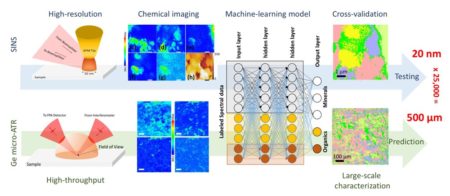
Machine learning was used to interpret the microscale heterogeneity of shale materials that influence water quality, based on their nanoscale properties.
It is well known that the organic and mineralogical heterogeneity in shale, which can be visualized at micrometer and nanometer spatial scales with various spectroscopic and microscopic techniques, contributes to the quality of gas reserves, gas flow mechanisms, and gas production from the subsurface. Scientists have now identified a way to use a machine learning approach to build a molecular distribution map of the surface of shale-sedimentary rocks, which are composed of minerals and organic matter.
The flow of fluids through shale’s nanoporous networks is fundamental to hydraulic fracturing and enhanced geothermal heating as well as to carbon sequestration and water storage. Thus, understanding shale chemistry at both the nano and mesoscale is relevant to energy production, climate-change mitigation, and sustainable water and land use.
Summary
The organic and mineralogical heterogeneity in shale at micrometer and nanometer spatial scales contributes to the quality of gas reserves, gas flow mechanisms and gas production. In a new study, a team from LBNL demonstrated two molecular imaging approaches based on infrared spectroscopy that enable the team to obtain mineral and kerogen information at mesoscale spatial resolutions in large-sized shale rock samples. The first method used a modified microscopic attenuated total reflectance measurement that employs a large germanium hemisphere combined with a focal plane array detector to rapidly capture chemical images of shale rock surfaces spanning hundreds of micrometers with micrometer spatial resolution. The second method, synchrotron infrared nano-spectroscopy, employs a metallic atomic force microscope tip to obtain chemical images of micrometer dimensions but with nanometer spatial resolution. This chemically “deconvoluted” imaging at the nano-pore scale was then used to build a machine learning model to generate a molecular distribution map across scales with a spatial span of 1000 times, which enabled high-throughput geochemical characterization in greater details across the nano-pore and micro-grain scales and allows the team to identify co-localization of mineral phases with chemically distinct organics and even with gas phase sorbents. This type of characterization is fundamental to understand mineral and organic compositions affecting the behavior of shales.
Citation
Hao, Z.; Bechtel, H. A.; Kneafsey, T.; Gilbert, B.; Nico, P. S. (2018), Cross-Scale Molecular Analysis of Chemical Heterogeneity in Shale Rocks, Scientific Reports, 8, 9, DOI: 10.1038/s41598-018-20365-6.
